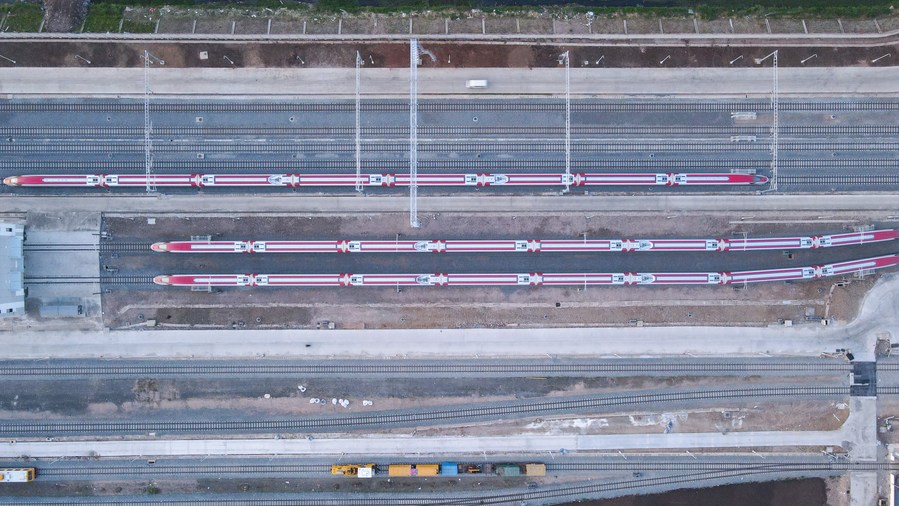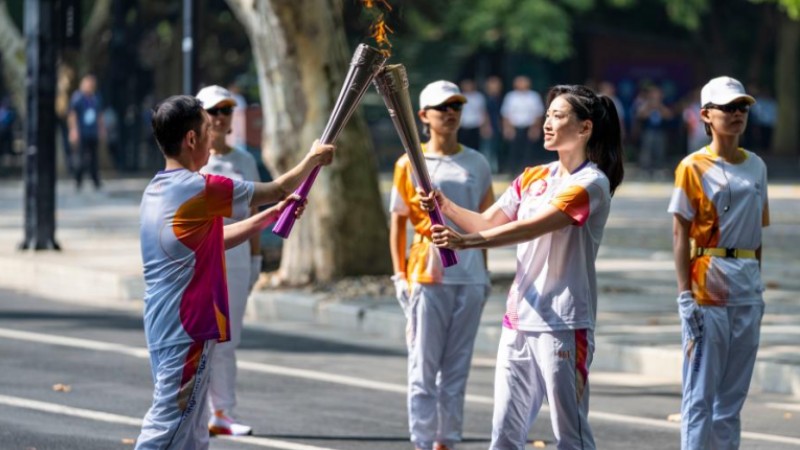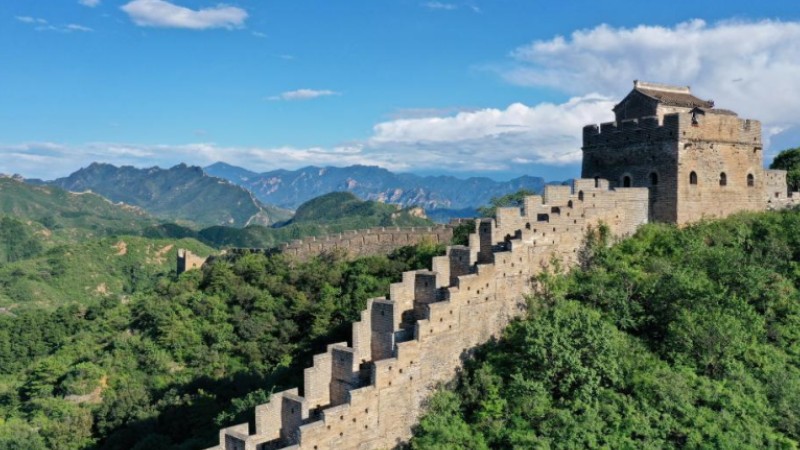Ten years on, Belt and Road remains vital contributor to global development, stability

This aerial photo taken on July 20, 2023 shows trains of Jakarta-Bandung High-Speed Railway (HSR) parking near a train station in Bandung, Indonesia. (Xinhua/Xu Qin)
"With the BRI, China promotes infrastructure development and connectivity across continents, offering a chance for countries to enhance their trade networks and expand their economic potential."
BEIJING, Sept. 8 (Xinhua) -- Not far away from downtown Jakarta, the capital of Indonesia, a high-speed railway jointly constructed by China and the southeast Asian country is about to see trains run at full steam.
The Jakarta-Bandung High-Speed Railway, a flagship project of China-Indonesia Belt and Road cooperation, is the first overseas high-speed railway project that fully uses Chinese railway systems, technology, and industrial components, and will be the first high-speed railway in Indonesia and Southeast Asia.
Connecting Jakarta and Bandung, the fourth largest city in Indonesia, the railway is 142 km long and has a design maximum speed of 350 km per hour. It will cut the journey time between the two places from over three hours to around 40 minutes.
The railway is indeed a shining example of the infrastructure connectivity achieved through the Belt and Road Initiative (BRI), which China pioneered in the autumn of 2013.
ENHANCED CONNECTIVITY
Many other iconic projects under the BRI have been completed as scheduled and with high quality, including the China-Laos Railway. Since its launch in December 2021, the 1,035-km rail line, which links the Lao capital, Vientiane, with Kunming, the capital of southwest China's Yunnan Province, has generated enormous benefits.

This aerial photo taken on Aug. 9, 2022 shows trucks for cross-border goods transportation at Vientiane South Station of China-Laos Railway in Laos. (Photo by Kaikeo Saiyasane/Xinhua)
With 19 million passengers and 24 million tonnes of freight delivered and its cross-border cargo transport covering over 10 countries and regions, the railway has dovetailed China-proposed BRI with Laos' strategy to convert itself from a landlocked country to a land-linked hub on the Indo-China Peninsula.
"The railway marks a milestone of the two countries' friendship in a new era," said Manila Sombandith, the consul general of Laos in Kunming.
In other directions, the Belt and Road cooperation is also flourishing. According to official data, the China-Europe Railway Express, a flagship project connecting China and Europe, has reached 211 cities in 25 European countries, and the New International Land-Sea Trade Corridor has connected China's central and western regions with more than 300 ports in over 100 countries.
"With the BRI, China promotes infrastructure development and connectivity across continents, offering a chance for countries to enhance their trade networks and expand their economic potential," said Seun Sam, a policy analyst at the Royal Academy of Cambodia.
Over the past decade, the BRI has also witnessed close collaboration between China and its partners in policy coordination, trade facilitation, financial integration and people-to-people exchanges, achieving fruitful outcomes.
China has signed more than 200 cooperation documents on Belt and Road cooperation with 152 countries and 32 international organizations, covering 83 percent of the countries with which China has established diplomatic relations.
Financial cooperation has also been enhanced. As of the end of 2022, the China-proposed Asian Infrastructure Investment Bank has approved 202 projects with financing exceeding 38.8 billion dollars, making it a crucial financing platform for the BRI.

A staff member cleans a comprehensive inspection train at a workshop for the Jakarta-Bandung High-Speed Railway in Bandung, Indonesia, June 21, 2023. (Xinhua/Xu Qin)
CHINESE WISDOM
As the world is facing emerging challenges, the BRI, a key platform for building a community with a shared future for humanity, provides Chinese wisdom for the world to achieve lasting peace and prosperity.
With a sluggish global economic recovery, global development needs strong drivers. The BRI has brought more prosperous international investment and trade. The World Bank estimates that the full implementation of transport projects under the framework could increase global income by 0.7 percent to 2.9 percent by 2030, lifting 7.6 million people out of extreme poverty and 32 million out of moderate poverty.
According to Julio Rios, a Spanish expert on China, the BRI is widely popular among developing countries. The initiative has become a public good, contributing not only to China but also to the modernization of the world, he said.
The BRI has enabled countries to jointly enlarge the pie of common interests and increased the popularity of win-win cooperation. Following the principle of extensive consultation, joint contribution and shared benefits, it has promoted true multilateralism and set an example of what is democratic and just global governance.
The BRI has brought tremendous advantages to all participating countries and has become a long-term strategy to promote intra-regional and inter-regional connectivity and cooperation in all areas, such as infrastructure, connectivity, economy, investment, finance, and people-to-people exchanges, said Kin Phea, director-general of the International Relations Institute of Cambodia, a think-tank under the Royal Academy of Cambodia.
"It is a new global force of peace, security, stability, development, prosperity, and harmony," he said.
Photos
Related Stories
- Hongkong Post issues commemorative stamps to mark 10th anniversary of BRI
- BRI helps Pakistan improve energy supply and infrastructure construction
- BRI hailed as balanced, mutually beneficial path
- Over 90 countries' representatives confirm participation in 3rd Belt and Road Forum for Int'l Cooperation: spokesperson
- Chinese FM meets Grenada's minister for foreign affairs
- Belt and Road law-ascertainment cooperation mechanism launched in Beijing
- Europe urged to end prejudices on BRI
- How ancient city on Silk Road attracts global fans
- Countries along Belt and Road share service trade dividends
- BRI helps Africa become frontier of development; ‘debt trap’ rhetoric is more of political narrative, propaganda of West: African scholar
Copyright © 2023 People's Daily Online. All Rights Reserved.









